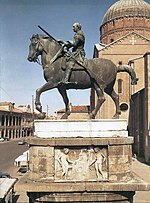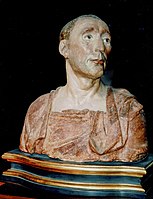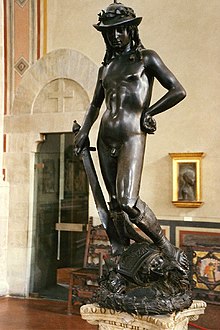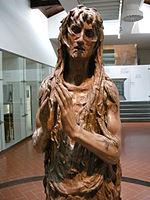Donatello
Donatello | |
|---|---|
 16th-century portrait | |
| Born | Donato di Niccolò di Betto Bardi c. 1386 |
| Died | 13 December 1466 (aged 79–80) Republic of Florence |
| Nationality | Florentine |
| Education | Lorenzo Ghiberti |
| Known for | Sculpture |
Notable work | Saint George, David, Equestrian Monument of Gattamelata |
| Movement | Early Renaissance |
Donato di Niccolò di Betto Bardi (c. 1386 – 13 December 1466), better known as Donatello (English: /ˌdɒnəˈtɛloʊ/[1] Italian: [donaˈtɛllo]), was an Italian sculptor of the Renaissance. Born in Florence, he studied classical sculpture and used this to develop a complete Renaissance style in sculpture, whose periods in Rome, Padua and Siena introduced to other parts of Italy a long and productive career. Financed by Cosimo de' Medici, Donatello's David, was the first freestanding nude male sculpture since antiquity.
He worked with stone, bronze, wood, clay, stucco and wax, and had several assistants, with four perhaps being a typical number. Though his best-known works were mostly statues in the round, he developed a new, very shallow, type of bas-relief for small works, and a good deal of his output was larger architectural reliefs.
Early life[]

Donatello was the son of Niccolò di Betto Bardi, who was a member of the Florentine Arte della Lana, and was born in Florence, probably in the year 1386. Donatello was educated in the house of the Martelli family.[2] He apparently received his early artistic training in a goldsmith's workshop,[citation needed] and then worked briefly in the studio of Lorenzo Ghiberti.[3]
In Pistoia in 1401, Donatello met the older Filippo Brunelleschi, with whom he may have had a romantic relationship. They likely went to Rome together around 1403, staying until the next year, to study the architectural ruins. Brunelleschi informally tutored Donatello in goldsmithing and sculpture.[4] Brunelleschi's buildings and Donatello's sculptures are both considered supreme expressions of the spirit of this era in architecture and sculpture, and they exercised a potent influence upon the artists of the age.
Work in Florence[]


In Florence, Donatello assisted Lorenzo Ghiberti with the statues of prophets for the north door of the Baptistery of Florence Cathedral, for which he received payment in November 1406 and early 1408. In 1409–1411 he executed the colossal seated figure of Saint John the Evangelist, which until 1588 occupied a niche of the old cathedral façade, and is now placed in the Museo dell' Opera del Duomo. This work marks a decisive step forward from late Gothic Mannerism in the search for naturalism and the rendering of human feelings.[5] The face, the shoulders and the bust are still idealized, while the hands and the fold of cloth over the legs are more realistic.
In 1411–1413, Donatello worked on a statue of St. Mark for the guild church of Orsanmichele. In 1417 he completed the Saint George for the Confraternity of the Cuirass-makers. From 1423 is the Saint Louis of Toulouse for the Orsanmichele, now in the Museum of the Basilica di Santa Croce. Donatello had also sculpted the classical frame for this work, which remains, while the statue was moved in 1460 and replaced by the Incredulity of Saint Thomas by Verrocchio.
Between 1415 and 1426, Donatello created five statues for the campanile of Santa Maria del Fiore in Florence, also known as the Duomo. These works are the Beardless Prophet; Bearded Prophet (both from 1415); the Sacrifice of Isaac (1421); Habbakuk (1423–25); and Jeremiah (1423–26); which follow the classical models for orators and are characterized by strong portrait details. From the 1420's is the Pazzi Madonna relief in Berlin. In 1425, he executed the notable Crucifix for Santa Croce; this work portrays Christ in a moment of the agony, eyes and mouth partially opened, the body contracted in an ungraceful posture.
From 1425 to 1427, Donatello collaborated with Michelozzo on the funerary monument of the Antipope John XXIII for the Battistero in Florence. Donatello made the recumbent bronze figure of the deceased, under a shell. In 1427, he completed in Pisa a marble relief for the funerary monument of Cardinal Rainaldo Brancacci at the church of Sant'Angelo a Nilo in Naples. In the same period, he executed the relief of The Feast of Herod (c. 1427) and the statues of Faith and Hope for the Baptistery of San Giovanni in Siena. The Feast of Herod is mostly in stiacciato (a very low bas-relief), with the foreground figures done in bas-relief, and is one of the first examples of one-point perspective in sculpture.
Donatello also restored antique sculptures for the Palazzo Medici.[6]
Bronze David[]
Donatello's bronze David, now in the Bargello museum, is Donatello's most famous work, and the first known free-standing nude statue produced since antiquity. Conceived fully in the round, independent of any architectural surroundings, and largely representing an allegory of the civic virtues triumphing over brutality and irrationality, it is arguably the first major work of Renaissance sculpture. It was commissioned by Cosimo de' Medici for the courtyard of his Palazzo Medici, but its date remains the subject of debate. It is most often dated to the 1440s, but dates as later as the 1460s have support from some scholars. It is not to be confused with his stone David, with clothes, of about 1408–09.

Some have perceived the David as having homoerotic qualities, and have argued that this reflected the artist's own orientation.[7] The historian Paul Strathern makes the claim that Donatello made no secret of his homosexuality, and that his behaviour was tolerated by his friends.[8] The main evidence comes from anecdotes by Angelo Poliziano in his "Detti piacevoli", where he writes about Donatello surrounding himself with "handsome assistants" and chasing in search of one that had fled his workshop.[9] This may not be surprising in the context of attitudes prevailing in the 15th- and 16th-century Florentine republic. However, little detail is known with certainty about his private life, and no mention of his sexuality has been found in the Florentine archives (in terms of denunciations)[10] albeit which during this period are incomplete.[11]
Rome, Prato and Venice[]
When Cosimo was exiled from Florence, Donatello went to Rome, remaining until 1433. The two works that testify to his presence in this city, the Tomb of Giovanni Crivelli at Santa Maria in Aracoeli, and the Ciborium at St. Peter's Basilica, bear a strong stamp of classical influence.
Donatello's return to Florence almost coincided with Cosimo's. In May 1434, he signed a contract for the marble pulpit on the facade of Prato cathedral, the last project executed in collaboration with Michelozzo. This work, a passionate, pagan, rhythmically conceived bacchanalian dance of half-nude putti, was the forerunner of the great Cantoria, or singing tribune, at the Duomo in Florence on which Donatello worked intermittently from 1433 to 1440 and was inspired by ancient sarcophagi and Byzantine ivory chests. In 1435, he executed the Annunciation for the Cavalcanti altar in Santa Croce, inspired by 14th-century iconography, and in 1437–1443, he worked in the Old Sacristy of the San Lorenzo in Florence, on two doors and lunettes portraying saints, as well as eight stucco tondoes. From 1438 is the wooden statue of St. John the Baptist for Santa Maria Gloriosa dei Frari in Venice. Around 1440, he executed a bust of a Young Man with a Cameo now in the Bargello, the first example of a lay bust portrait since the classical era.
In Padua[]

In 1443, Donatello was called to Padua by the heirs of the famous condottiero Erasmo da Narni (better known as the Gattamelata, or "Honey-Cat"), who had died that year. Completed in 1450 and placed in the square facing the Basilica of St. Anthony, his Equestrian Monument of Gattamelata was the first example of such a monument since ancient times. (Other equestrian statues, from the 14th century, had not been executed in bronze and had been placed over tombs rather than erected independently, in a public place.) This work became the prototype for other equestrian monuments executed in Italy and Europe in the following centuries.
For the Basilica of St. Anthony, Donatello created, most famously, the bronze Crucifix of 1444–47 and additional statues for the choir, including a Madonna with Child and six saints, constituting a Holy Conversation, which is no longer visible since the renovation by Camillo Boito in 1895. The Madonna with Child portrays the Child being displayed to the faithful, on a throne flanked by two sphinxes, allegorical figures of knowledge. On the throne's back is a relief of Adam and Eve. During this period—1446–50—Donatello also executed four extremely important reliefs with scenes from the life of St. Anthony for the high altar.
Main works[]
- St. Mark (1411–1413), Orsanmichele, Florence
- St. George Tabernacle (c. 1415–1417) – Museo Nazionale del Bargello, Florence
- Zuccone (1423–1425) – Museo dell'Opera del Duomo, Florence
- The Feast of Herod (c. 1425) – Baptismal font, Baptistry of San Giovanni, Siena
- David (c. 1425–1430) – Museo Nazionale del Bargello, Florence
- Madonna of the Clouds (c. 1425–1435) – Museum of Fine Arts, Boston
- Madonna and Child (c. 1440) – Musée du Louvre, Paris
- Equestrian Monument of Gattamelata (1445–1450) – Piazza del Santo, Padua
- Magdalene Penitent (c. 1455) – Museo dell'Opera del Duomo, Florence
- Judith and Holofernes (1455–1460) – Palazzo Vecchio, Florence
- Virgin and Child with Four Angels or Chellini Madonna (1456), Victoria and Albert Museum

Bust of Niccolo da Uzzano by Donatello in Museo Nazionale del Bargello, Florence, Italy.
Magdalene Penitent (c. 1455) – Museo dell'Opera del Duomo, Florence.
Saint John the Evangelist (1408-1415), which until 1588 occupied a niche of the old Florence Cathedral façade, now at the Museo dell'Opera del Duomo.
Madonna and Child (Musée du Louvre, Paris)
In popular culture[]
Donatello is portrayed by Ben Starr in the 2016 television series Medici: Masters of Florence.[12]
Donatello in the Teenage Mutant Ninja Turtles is named after him.
The Donatello Multi-Purpose Logistics Module (MPLM) built by the Italian Space Agency, was one of three MPLMs operated by NASA to transfer supplies and equipment to and from the International Space Station. The others were named Leonardo and Raffaello.
2020 discovery[]

In 2020 art historian Gianluca Amato, as part of his research on wooden crucifixes crafted between the late thirteenth and the first half of the sixteenth century for his doctoral thesis at the University of Naples Federico II, discovered that the crucifix of the church of Sant'Angelo a Legnaia was sculpted by Donatello. This discovery has been historically evaluated considering that the work belonged to the Compagnia di Sant'Agostino which was based in the oratory adjacent to the mother church of Sant'Angelo a Legnaia. Silvia Bensì performed restoration work on the crucifix.[13][14][15][16]
References[]
- ^ Wells, John (3 April 2008). Longman Pronunciation Dictionary (3rd ed.). Pearson Longman. ISBN 978-1-4058-8118-0.
- ^ Rubin, Patricia Lee. Giorgio Vasari: Art and History. p. 350. ISBN 9780300049091.
- ^ Walker, Paul Robert (2003). The Feud That Sparked the Renaissance. New York: William Morrow. pp. xi. ISBN 9780061743559.
- ^ Walker, Paul Robert (2003). The Feud That Sparked the Renaissance. New York: William Morrow. pp. 26, 30, 34. ISBN 9780061743559.
- ^ Janson, The Sculpture of Donatello, Princeton, 1963.
- ^ Hesson, Robert (28 July 2019). "Collections and restoration of antiquities – Ancient Monuments". Northern Architecture. Retrieved 21 September 2020.
- ^ H.W. Janson, The Sculpture of Donatello, Princeton, 1957, II, 77–86; Laurie Schneider, "Donatello's Bronze David," The Art Bulletin, 55 (1973) 213–216.
- ^ Paul Strathern, The Medici: Godfathers of the Renaissance, London, 2003
- ^ Michael Rocke, Forbidden Friendships: Homosexuality and Male Culture in Renaissance Florence[page needed]
- ^ J. Poeschke, Donatello and His World (1994)
- ^ Louis Crompton, Homosexuality and Civilization, Harvard Press, 2003, p. 264.
- ^ "Medici: Masters of Florence". Internet Movie Database. Retrieved 24 December 2016.
- ^ Mugnaini, Olga (6 March 2020). "'Quel crocifisso ligneo è di Donatello', la sensazionale scoperta a Firenze". La Nazione (in Italian). Retrieved 26 March 2020.
- ^ "Studioso scopre Crocifisso inedito di Donatello". Adnkronos. Retrieved 26 March 2020.
- ^ Salzano, Marco Pipolo & Guido. "E". QAeditoria.it – QA turismo cultura & arte. Retrieved 26 March 2020.
- ^ "Crocifisso di Donatello nella chiesa di Legnaia, la storia". Isolotto Legnaia Firenze (in Italian). 6 March 2020. Retrieved 26 March 2020.
This article incorporates text from a publication now in the public domain: Chisholm, Hugh, ed. (1911). "Donatello". Encyclopædia Britannica. 8 (11th ed.). Cambridge University Press. pp. 406–408.
Further reading[]
- Avery, Charles, Donatello: An Introduction, New York, 1994.
- Avery, Charles, Donatello. Catalogo completo delle opere, Firenze 1991.
- Avery, Charles and McHam, Sarah Blake. "Donatello". Grove Art Online. Oxford Art Online. Oxford University Press. (subscription required)
- Bennett, Bonnie A. and Wilkins, David G., Donatello, Oxford 1984.
- Coonin, A. Victor, Donatello and the Dawn of Renaissance Art, Reaktion Books, London, 2019.
- Greenhalgh, Michael, Donatello and His Sources, Holmes & Meier Pub., 1982.
- Hartt, Frederick and Wilkins, David G., History of Italian Renaissance Art (7th ed.), Pearson, 2010.
- Janson, Horst W., The Sculpture of Donatello, Princeton University Press, 1957.
- Leach, Patricia Ann, Images of Political Triumph: Donatello's Iconography of Heroes, Princeton University Press, 1984.
- Olson, Roberta J.M., Italian Renaissance Sculpture, 1992, Thames & Hudson (World of Art), ISBN 978-0500202531
- Randolph, Adrian W.B., Engaging Symbols: Gender, Politics, and Public Art in Fifteenth-Century Florence. Yale University Press, 2002.
- Vasari, Giorgio, Le vite de' più eccellenti pittori, scultori e architettori Lives of the Most Excellent Painters, Sculptors, and Architects, Firenze 1568, edizione a cura di R. Bettarini e P. Barocchi, Firenze, 1971.
- Wilson, Carolyn C., Renaissance Small Bronze Sculpture and Associated Decorative Arts, 1983, National Gallery of Art (Washington), ISBN 0894680676
External links[]
| Wikimedia Commons has media related to Donatello. |
- Donatello
- Italian Renaissance sculptors
- 1380s births
- 1466 deaths
- Sculptors from Florence
- Italian male sculptors
- 15th-century people of the Republic of Florence
- Burials at San Lorenzo, Florence
- Italian Roman Catholics
- Renaissance sculptors
- 15th-century Italian sculptors
- Catholic sculptors





